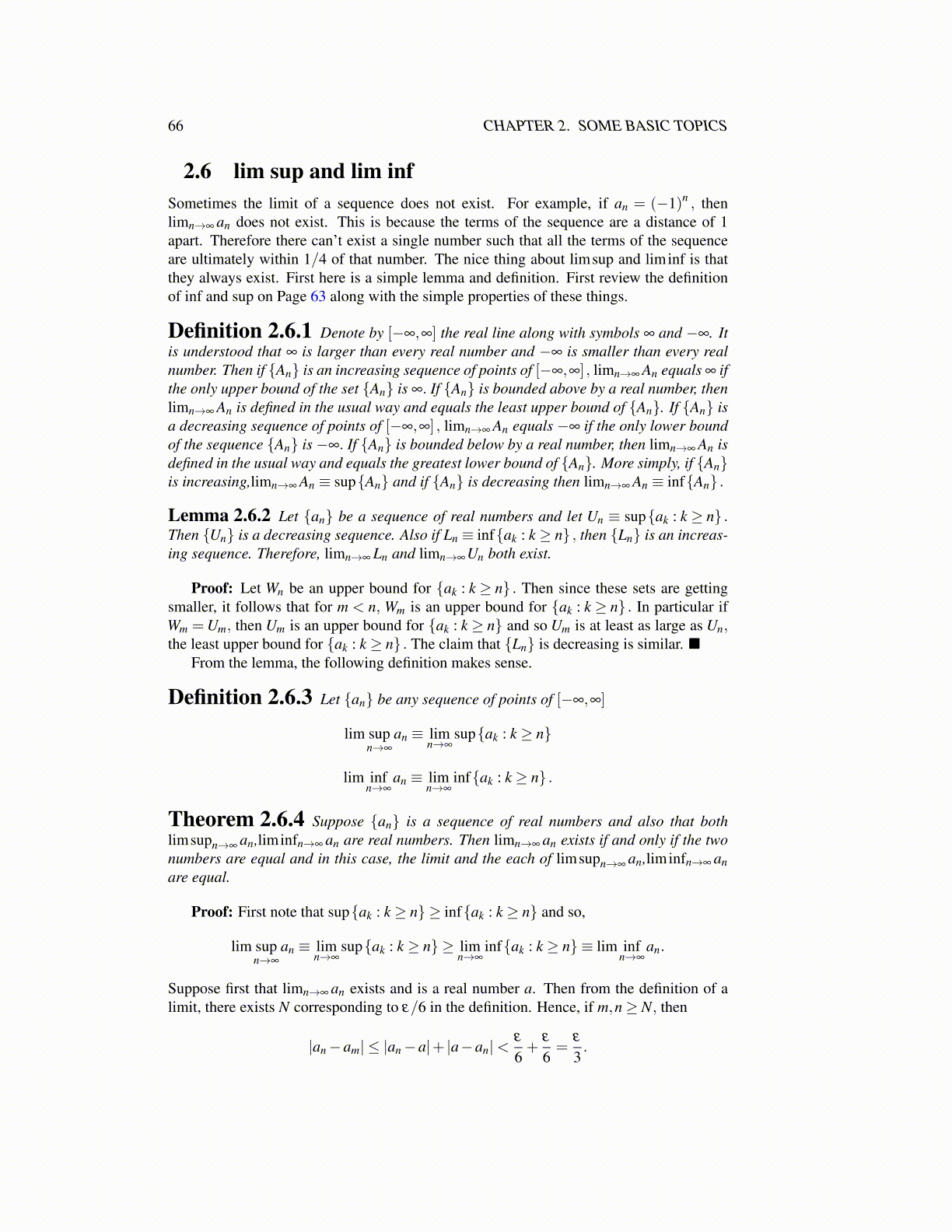
66 CHAPTER 2. SOME BASIC TOPICS
2.6 lim sup and lim infSometimes the limit of a sequence does not exist. For example, if an = (−1)n , thenlimn→∞ an does not exist. This is because the terms of the sequence are a distance of 1apart. Therefore there can’t exist a single number such that all the terms of the sequenceare ultimately within 1/4 of that number. The nice thing about limsup and liminf is thatthey always exist. First here is a simple lemma and definition. First review the definitionof inf and sup on Page 63 along with the simple properties of these things.
Definition 2.6.1 Denote by [−∞,∞] the real line along with symbols ∞ and −∞. Itis understood that ∞ is larger than every real number and −∞ is smaller than every realnumber. Then if {An} is an increasing sequence of points of [−∞,∞] , limn→∞ An equals ∞ ifthe only upper bound of the set {An} is ∞. If {An} is bounded above by a real number, thenlimn→∞ An is defined in the usual way and equals the least upper bound of {An}. If {An} isa decreasing sequence of points of [−∞,∞] , limn→∞ An equals −∞ if the only lower boundof the sequence {An} is −∞. If {An} is bounded below by a real number, then limn→∞ An isdefined in the usual way and equals the greatest lower bound of {An}. More simply, if {An}is increasing,limn→∞ An ≡ sup{An} and if {An} is decreasing then limn→∞ An ≡ inf{An} .
Lemma 2.6.2 Let {an} be a sequence of real numbers and let Un ≡ sup{ak : k ≥ n} .Then {Un} is a decreasing sequence. Also if Ln ≡ inf{ak : k ≥ n} , then {Ln} is an increas-ing sequence. Therefore, limn→∞ Ln and limn→∞ Un both exist.
Proof: Let Wn be an upper bound for {ak : k ≥ n} . Then since these sets are gettingsmaller, it follows that for m < n, Wm is an upper bound for {ak : k ≥ n} . In particular ifWm =Um, then Um is an upper bound for {ak : k ≥ n} and so Um is at least as large as Un,the least upper bound for {ak : k ≥ n} . The claim that {Ln} is decreasing is similar. ■
From the lemma, the following definition makes sense.
Definition 2.6.3 Let {an} be any sequence of points of [−∞,∞]
lim supn→∞
an ≡ limn→∞
sup{ak : k ≥ n}
lim infn→∞
an ≡ limn→∞
inf{ak : k ≥ n} .
Theorem 2.6.4 Suppose {an} is a sequence of real numbers and also that bothlimsupn→∞ an,liminfn→∞ an are real numbers. Then limn→∞ an exists if and only if the twonumbers are equal and in this case, the limit and the each of limsupn→∞ an,liminfn→∞ anare equal.
Proof: First note that sup{ak : k ≥ n} ≥ inf{ak : k ≥ n} and so,
lim supn→∞
an ≡ limn→∞
sup{ak : k ≥ n} ≥ limn→∞
inf{ak : k ≥ n} ≡ lim infn→∞
an.
Suppose first that limn→∞ an exists and is a real number a. Then from the definition of alimit, there exists N corresponding to ε/6 in the definition. Hence, if m,n≥ N, then
|an−am| ≤ |an−a|+ |a−an|<ε
6+
ε
6=
ε
3.